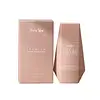What's inside
What's inside
 Key Ingredients
Key Ingredients

 Benefits
Benefits

 Concerns
Concerns

 Ingredients Side-by-side
Ingredients Side-by-side

Water
Skin ConditioningIsododecane
EmollientPolysorbate 20
EmulsifyingButylene Glycol
HumectantSodium Acrylates/Beheneth-25 Methacrylate Crosspolymer
Skin ConditioningMethyl Methacrylate Crosspolymer
Hydrogenated Polydecene
EmollientLauryl Glucoside
CleansingDimethicone
EmollientTrimethylsiloxysilicate
EmollientEthylhexyl Methoxycinnamate
UV AbsorberTitanium Dioxide
Cosmetic ColorantTriethoxycaprylylsilane
PEG-20 Methyl Glucose Sesquistearate
EmulsifyingPolyhydroxystearic Acid
EmulsifyingNeopentyl Glycol Diethylhexanoate
EmollientPhenoxyethanol
PreservativeCI 77492
Cosmetic ColorantTriethanolamine
BufferingOctyldodecanol
EmollientEchium Plantagineum Seed Oil
Skin ConditioningHelianthus Annuus Seed Oil
EmollientCardiospermum Halicacabum Seed Extract
AntimicrobialCardiospermum Halicacabum Flower/Leaf/Vine Extract
Skin ConditioningNelumbo Nucifera Leaf Extract
Skin ConditioningAcrylates/C10-30 Alkyl Acrylate Crosspolymer
Emulsion StabilisingPEG-240
HumectantEthyl Ether
SolventSphingomonas Ferment Extract
Skin ConditioningDisodium EDTA
Water, Isododecane, Polysorbate 20, Butylene Glycol, Sodium Acrylates/Beheneth-25 Methacrylate Crosspolymer, Methyl Methacrylate Crosspolymer, Hydrogenated Polydecene, Lauryl Glucoside, Dimethicone, Trimethylsiloxysilicate, Ethylhexyl Methoxycinnamate, Titanium Dioxide, Triethoxycaprylylsilane, PEG-20 Methyl Glucose Sesquistearate, Polyhydroxystearic Acid, Neopentyl Glycol Diethylhexanoate, Phenoxyethanol, CI 77492, Triethanolamine, Octyldodecanol, Echium Plantagineum Seed Oil, Helianthus Annuus Seed Oil, Cardiospermum Halicacabum Seed Extract, Cardiospermum Halicacabum Flower/Leaf/Vine Extract, Nelumbo Nucifera Leaf Extract, Acrylates/C10-30 Alkyl Acrylate Crosspolymer, PEG-240, Ethyl Ether, Sphingomonas Ferment Extract, Disodium EDTA
Water
Skin ConditioningAloe Barbadensis Leaf Juice
Skin ConditioningGlycerin
HumectantButyl Methoxydibenzoylmethane
UV AbsorberOctocrylene
UV AbsorberEthylhexyl Methoxycinnamate
UV AbsorberPolyacrylate-1 Crosspolymer
Stearic Acid
CleansingDimethicone
EmollientCyclopentasiloxane
EmollientNiacinamide
SmoothingSalvia Officinalis Extract
AntimicrobialHyaluronic Acid
HumectantCentella Asiatica Extract
CleansingRosa Damascena Flower Water Extract
AntioxidantLecithin
EmollientDipotassium Glycyrrhizate
HumectantIsopropyl Myristate
EmollientPEG-40 Hydrogenated Castor Oil
EmulsifyingCarbomer
Emulsion StabilisingHydrolyzed Collagen
EmollientRice Bran Acid
CleansingSqualane
EmollientPhenoxyethanol
PreservativeEthylhexylglycerin
Skin ConditioningWater, Aloe Barbadensis Leaf Juice, Glycerin, Butyl Methoxydibenzoylmethane, Octocrylene, Ethylhexyl Methoxycinnamate, Polyacrylate-1 Crosspolymer, Stearic Acid, Dimethicone, Cyclopentasiloxane, Niacinamide, Salvia Officinalis Extract, Hyaluronic Acid, Centella Asiatica Extract, Rosa Damascena Flower Water Extract, Lecithin, Dipotassium Glycyrrhizate, Isopropyl Myristate, PEG-40 Hydrogenated Castor Oil, Carbomer, Hydrolyzed Collagen, Rice Bran Acid, Squalane, Phenoxyethanol, Ethylhexylglycerin
Ingredients Explained
These ingredients are found in both products.
Ingredients higher up in an ingredient list are typically present in a larger amount.
Dimethicone is a type of synthetic silicone created from natural materials such as quartz.
What it does:
Dimethicone comes in different viscosities:
Depending on the viscosity, dimethicone has different properties.
Ingredients lists don't always show which type is used, so we recommend reaching out to the brand if you have questions about the viscosity.
This ingredient is unlikely to cause irritation because it does not get absorbed into skin. However, people with silicone allergies should be careful about using this ingredient.
Note: Dimethicone may contribute to pilling. This is because it is not oil or water soluble, so pilling may occur when layered with products. When mixed with heavy oils in a formula, the outcome is also quite greasy.
Learn more about DimethiconeEthylhexyl Methoxycinnamate is an organic compound that provides UVB protection. It often goes by the more common name of octinoxate. It is created from methoxycinnamic acid and 2-ethylhexanol.
Ethylhexyl Methoxycinnamate absorbs UVB rays with wavelengths between 280-320 nm. UV absorbers protect your skin by using chemical reactions to convert UV rays into heat and energy.
UVB (290-320 nm) rays emit more energy than UVA rays. They are capable of damaging DNA, causing sunburns and are thought to be linked to skin cancer.
The state of Hawaii has banned sunscreens containing octinoxate due to its potential impact on coral reefs. More research is needed to bridge gaps in this research. The European Union allows higher levels of octinoxate in sunscreens than the US and Australia.
Ethylhexyl Methoxycinnamate is oil soluble. It is not stable and may lose efficacy when exposed to sunlight.
Learn more about Ethylhexyl MethoxycinnamatePhenoxyethanol is a preservative that has germicide, antimicrobial, and aromatic properties. Studies show that phenoxyethanol can prevent microbial growth. By itself, it has a scent that is similar to that of a rose.
It's often used in formulations along with Caprylyl Glycol to preserve the shelf life of products.
Water. It's the most common cosmetic ingredient of all. You'll usually see it at the top of ingredient lists, meaning that it makes up the largest part of the product.
So why is it so popular? Water most often acts as a solvent - this means that it helps dissolve other ingredients into the formulation.
You'll also recognize water as that liquid we all need to stay alive. If you see this, drink a glass of water. Stay hydrated!
Learn more about Water